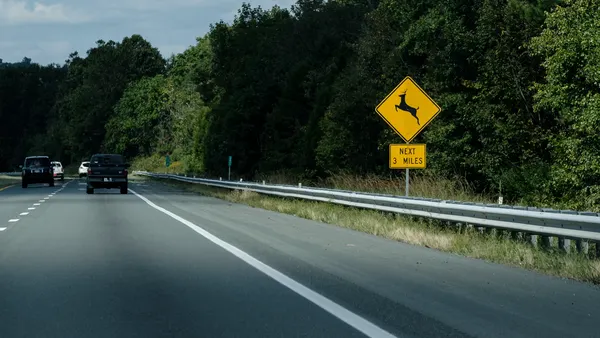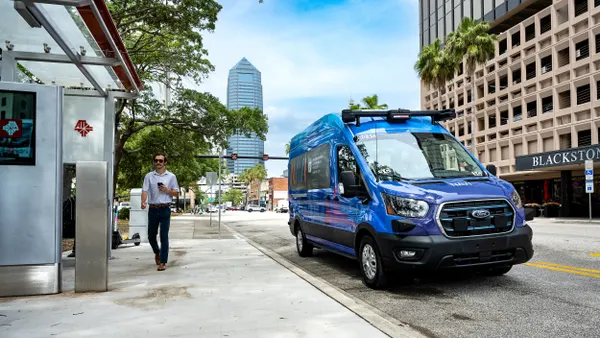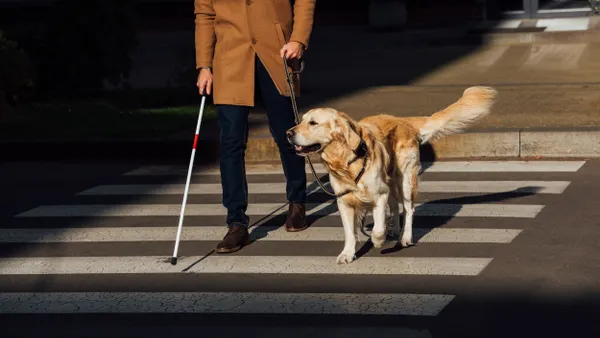Dive Brief:
- The U.S. Department of Transportation (USDOT) last week released its first Pedestrian Safety Action Plan in an effort to reduce pedestrian fatalities and injuries on America's roads. The plan is overseen by the Federal Highway Administration (FHWA) and National Highway Traffic Safety Administration (NHTSA).
- Under the plan, federal agencies will swiftly implement a number of initiatives by the end of this year to enhance public education around street safety; help governments improve the location of pedestrian crossings; and produce a guide on how streetlights can be designed to promote safety for pedestrians. Agencies will also identify ways to set appropriate speed limits and reduce speed-related fatalities, and investigate the effect of the use of electronic devices on pedestrian safety.
- The plan said various federal agencies intend to do more in the coming years to enhance safety through the study and use of automated driving technologies; training law enforcement on bicycle and pedestrian safety; examining how new bike and pedestrian infrastructure is designed; and supporting state and local governments’ efforts to adopt Vision Zero policies. In a statement, FHWA Administrator Nicole Nason said reducing pedestrian fatalities is a "team effort."
Dive Insight:
The action plan comes as the U.S. continues to wrestle with a growth in pedestrian fatalities on its streets, especially in cities. NHTSA said 17% of all traffic fatalities in 2019 were pedestrians; that year, the administration said 6,205 people were killed, an increase of 44% from 2010. The Governors Highway Safety Association (GHSA) projected a similar number of pedestrian fatalities earlier this year and has raised concerns about the continued growth of deaths on local roads, at night and outside of intersections.
Russ Martin, GHSA's senior director of policy and government relations, said in an email that the association is "encouraged" by USDOT's focus on pedestrian safety and said the action plan provides many ways for the federal and state governments "to gather better data and bring more attention to this crisis."
The U.S. came under fire earlier this year for declining to sign a pledge at the Global Ministerial Conference on Road Safety in Stockholm, instead issuing an uncredited statement on behalf of its delegation. That statement pledged to continue studying the relationship between road safety and street design, and the action plan released last week focuses much of its attention on the design of pedestrian crossings.
In its only explicit nod to street infrastructure, NHTSA pledges in the action plan to "[identify] discrepancies in how new pedestrian and bicycle facilities are designed to be used versus how they are actually used by pedestrians, bicyclists, and motorists by examining knowledge of proper facility use, enforcement efforts, and documentation of available educational resources and initiatives."
While the plan acknowledges that some stakeholders called for greater support for Complete Streets policies, it does not explicitly call for implementing those policies nationwide, even as the movement has gathered steam among local governments and received support in Congress. A spokesperson for the National Complete Streets Coalition did not respond to requests for comment.
But the plan said it intends to "[identify], develop and promote speed management noteworthy practices that are carried out by States and localities to reduce speed-related fatalities and cover topics such as setting appropriate speed limits for all roadway users and countermeasures that slow traffic down."
That follows calls from the likes of the National Association of City Transportation Officials (NACTO) to reassess how governments design speed limits, as well as setting slow zones in a bid to reduce crashes, especially with speeding under further scrutiny during the coronavirus (COVID-19) pandemic.
Martin agreed with that assessment, noting that GHSA has also urged a renewed focus on speeding, which Martin said is "one of the leading crash contributors nationwide and itself poses an outsized threat to pedestrians and other nonmotorized road users."










